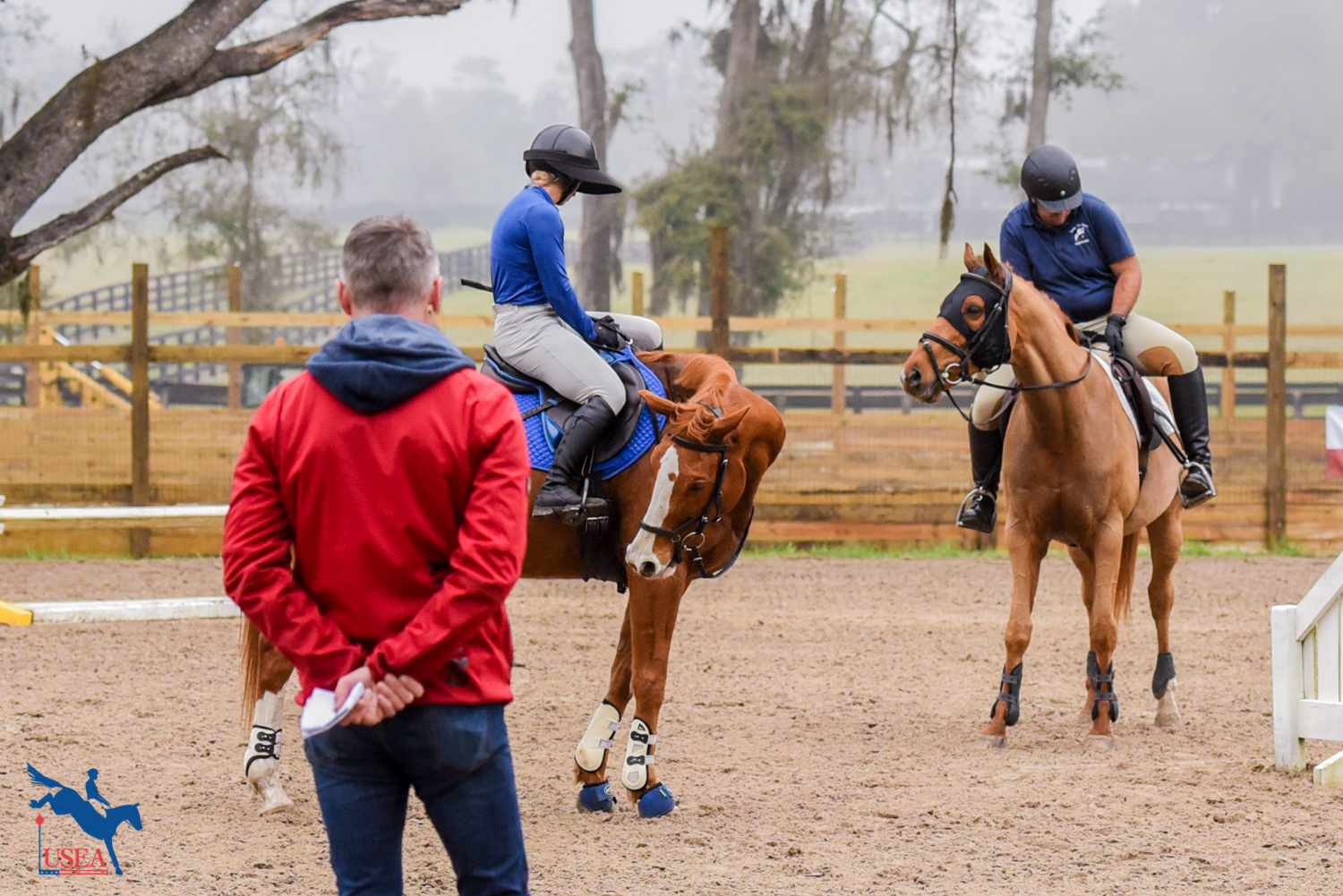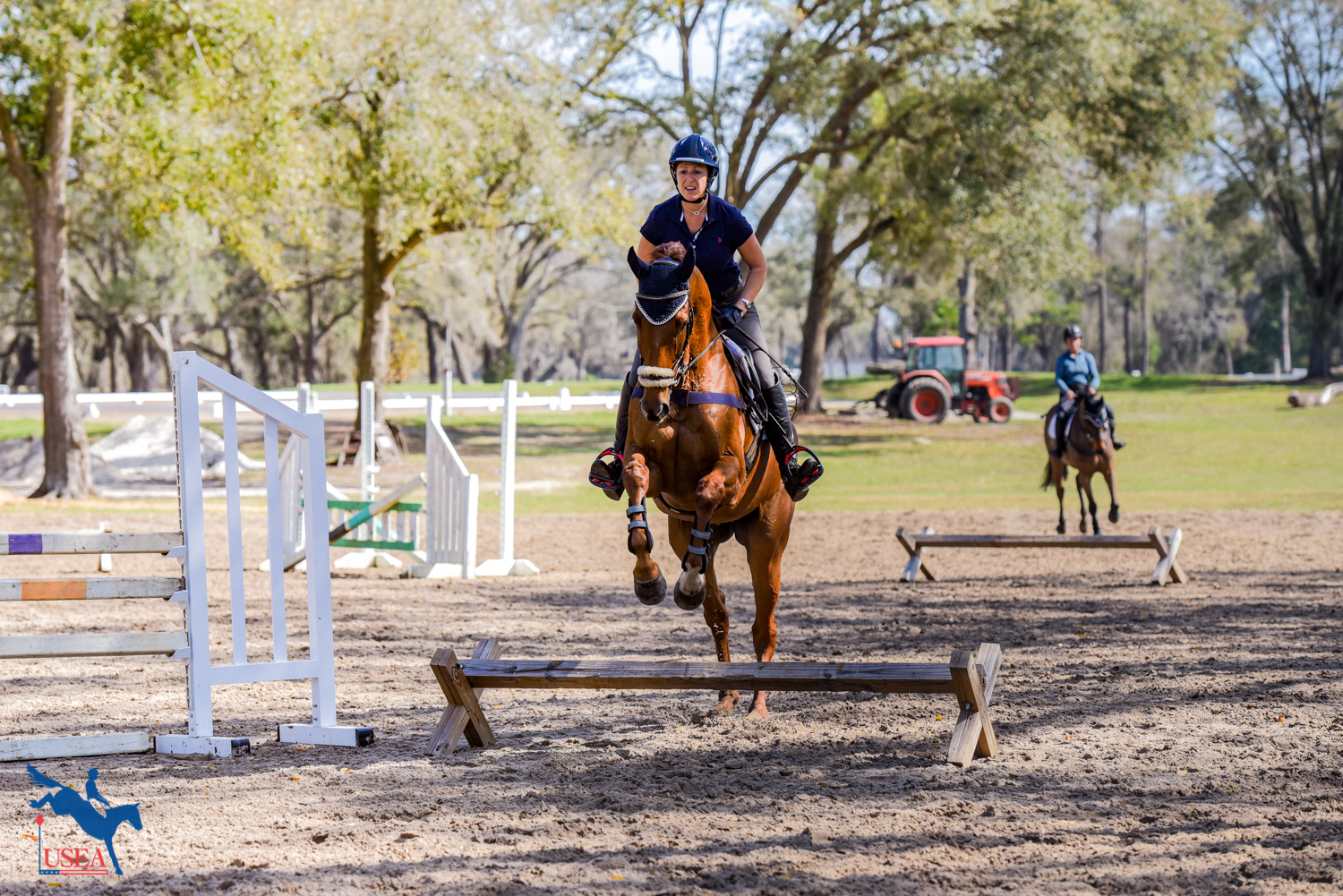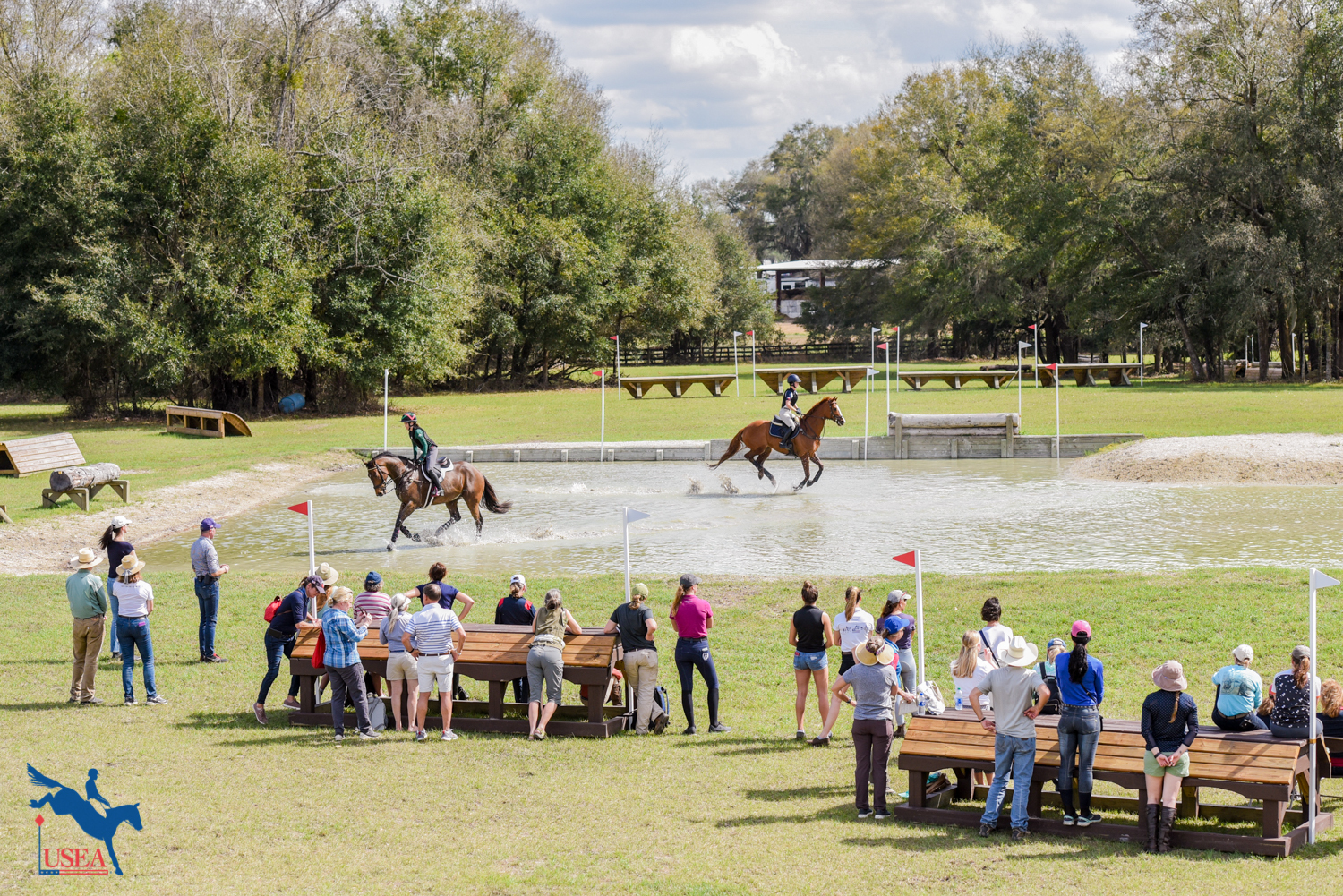Dibowski Wants You to Feel the Rhythm at the 2020 ICP Symposium

Yesterday Andreas Dibowski said that he was ready for the “fun stuff” and today he had the chance to share his knowledge of both show jumping and cross-country to a large audience who attended day two of the USEA Instructors’ Certification Program (ICP) Symposium. The morning started out in the ring at Barnstaple South with three groups of riders – Beginner Novice, Training, and Preliminary, and three groups of the same levels took to the cross-country in the afternoon. While the exercises and jumps got progressively harder throughout the day, the warm-ups and themes stayed the same.
Each group started with a stirrup check and Dibowski wasn’t shy about asking riders to raise their stirrups. “We need to use every sitting position,” he explained. “You can’t go in light seat and have a flexible ankle without shorter stirrups.” Rider position – especially leg position – was one of Dibowski’s big focuses of the day. He encouraged riders to land in their ankles and not their knees from the fence. He said, “when you grip with your knees your upper body will fall forward.” Dibowski didn’t want riders folding too much over the fences since it inhibits the horse’s ability to come up to you.

In both show jumping and cross-country Dibowski encouraged riders to lengthen their reins and then ride the horses forward from their hind legs to find the contact – a concept that was repeated from yesterday’s dressage lessons. He especially asked for long reins on down banks in order to give the horse a chance to use his whole body. “Sitting down in a car and pressing on the brake doesn’t work. Use your body and sit down and bring his hind leg under the gravity. Don’t just shorten your reins and pull on the bit.”
Dibowski also expressed his love of simple bits. “Don’t fix the bit and then fix the riding – fix the riding first,” he said. He also explained that he especially uses soft bits on horses that pull as “how can you ride off the hind end into the contact if your horse is in pain?”
When the riders’ stirrups were adjusted, their reins were lengthened, and their bits were commented on, Dibowski had the show jumping groups all warm up over cavaletti. Dibowski explained that “a cavaletti or pole is not a jump, it’s a stride. Just be sure your horse can lift up his back. Sit down, find the rhythm, change your weight to pressure in the stirrup and ride a straight line before, over, and after.” He had the riders sit down in the cavaletti lines in order to use their bodies to bring the horse’s hind leg under with more activity. For the Training and Preliminary groups, he put the cavaletti on turns and angles and didn’t worry about the strides between. “Cavaletti on an angle is good for warming up because the horse has to actually listen to the rider,” he said.

Dibowski followed a similar method on cross-country – all the groups warmed up over the same line of logs despite their level differences. “We always find a way back to the basics to find the rhythm,” he explained as he said that he uses the same basic exercises for his own top horses. “It is [footwork] for the horses and the balance of the riders. Never let your horse jump – you always have control over the stride before over and after. Develop a rhythm for the feeling of the horse.”
Feel the rhythm. Ride the rhythm. Keep the rhythm. Dibowski repeated these same phrases over and over throughout the day, as he was trying to keep horses and riders jumping in harmony. “The jump isn’t your enemy – you shouldn’t be attacking it or running away from it. It’s just a big canter stride that you should incorporate. It’s important to keep an active canter from behind so that the jumps don’t really matter in the end. It’s more important to work on the phases between the jumps,” he said.
Dibowski enjoyed putting the jumps up for the Training and Preliminary groups, but the concepts remained the exact same as they did over the cavaletti. “If you maintain a good rhythm the height doesn’t matter. If you maintain the positive energy it will be very easy to breathe in, sit up, and the jump will come up. You will have to work, but if you give your horse the positive energy it will be there,” he said.

With Dibowski’s emphasis on rhythm an attendee asked him about his thoughts of finding the perfect distance, and he replied. “A lot of riders do not have a good feeling for distance. I school a system where the distance isn’t that important. When the horse is uphill and in front of the rider then [the distance] is not important. It is more important for cross-country, but if you stay back and keep your horse together with the hind leg active then the horse can make a short stride at the end. If you keep him together then you will never see a wrong distance. The feeling is only learned by doing – you can’t explain it. Only doing and doing. It’s necessary to find a good distance, but it is wrong when the horse is dependent on your riding.”
While Dibowski often repeated “gallop” or “go more forward” to the show jump riders the cross-country riders got it even 10-fold with “more ground speed” his choice for feedback for 95% of the riders. He said that “it is a safety issue. If you are riding slower at home, then when you go to the show you aren’t prepared to jump out of the speed needed to make the time. A good pace sets you up to jump better. You aren’t racing, but it is better to jump out of a forward pace with an active hind end.”
The 2020 USEA Educational Symposium is taking place from February 17-20 at Barnstaple South in Ocala, Florida. On-site registration is available. Learn more here.
About the USEA Instructors’ Certification Program
Instructors are essential to the training of riders and horses for safe and educated participation in the sport of eventing. The USEA Instructors’ Certification Program (ICP) was initiated in 2002 to educate all levels of eventing instructor with essential training principles upon which those instructors can continue to build throughout their teaching careers. ICP offers educational workshops and assessments by which both regular instructors, Level I through Level IV, Young Event Horse (YEH) instructors, and Young Event Horse professional horse trainers can become ICP certified. Additional information about ICP’s goals, benefits, workshops, and assessments as well as names and contact information for current ICP-certified instructors, YEH instructors, and YEH professional horse trainers are available is available on the USEA website. Click here to learn more about the Instructors’ Certification Program.
The USEA would like to thank EquiAppraisal and C4 Belts for sponsoring the Instructors’ Certification Program.





































